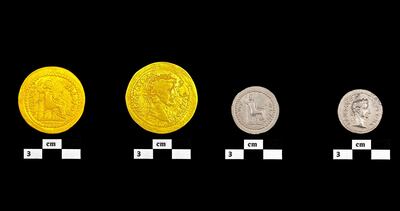Archaeologists working in Umm Al Quwain have made a series of striking finds during this season’s dig, further highlighting the emirate's significance to the country's development.
Experts at the ancient site of Tell Abraq have unearthed imitation Roman gold coins dating to the first century AD, as well as what is thought to be a pre-Islamic shrine and open-air altar, and a stone slab with an inscription in Aramaic.
Original Roman coins were minted in Lyon in France and were widely circulated for a long time in several cities and countries, such as India, which was part of the extensive Roman trade network.
Copies were often made of these and those found in Umm Al Quwain bear the image of Roman emperor Tiberius. But the rendering of the emperor is poor, they only imitate the shape of the letters as the script is not understood. And the weight of the coins is erratic.
It is not yet clear if the coins found in Umm Al Quwain were minted locally, regionally or in India but they point to a major phase of globalisation that occurred about 2,000 years ago amid a surge of interconnected trade across the Indian Ocean.
Uncovering UAE's deep roots
The discovery also sheds further light on the rich history of Umm Al Quwain following the unearthing of an ancient pearling village and a Christian monastery over the past several years
The emirate’s Department of Tourism and Archaeology said this season’s discovery marked a “significant departure” from previous work.
“These coins are among the most important archaeological discoveries of the season,” said Rania Hussein Kannouma, acting director of archaeology and heritage at the UAQ Department of Tourism and Archaeology.
“They are tangible material evidence of the qualitative economic leaps achieved by the Tell Abraq archaeological site.”

This season’s work, which concluded in December, was undertaken in conjunction with the Italian Mission in Umm Al Quwain.
UAQ's key role in Emirati progress
Dr Michele Degli Esposti, its co-director, said the discovery reflected the religious, economic and commercial significance of the site.
“The discovery adds new perspectives, enriches our understanding of the country’s history and underlines the inclusion of UAQ and the UAE in a story that is not only local but integrated into the whole Gulf,” Dr Degli Esposti told The National on Tuesday.
“It extends to Iran, India, Central Asia, the Romanised Levant and Arabia,” he said. “It gives us a better idea of the continuity of life in Umm Al Quwain and, in particular, around its lagoon.”
Dr Degli Esposti said it was the first time such coins were found during a regular dig in the coastal UAE, making them firmly connected to the site.
Four coins were found in the ground at Tell Abraq and one on the surface a short distance away.
“The coins ... represent the wide trade networks that existed then around the Gulf and, most probably, across to India," said Degli Esposti.
Turning to the other discoveries, it is thought the shrine was sheltered and possibly reserved for notable attendees while the open-air altar could have been used for pilgrims.
The Aramaic inscription is currently being studied and this might yield some clues as to the shrine’s dedication but it is not known what any ceremony would have been like.
Previous finds at the site included stone statues, bronze and clay figurines, which could potentially have been used as offerings, and incense burners which, Dr Degli Esposti says, lend support to the shrine theory.
The coins were found inside a small pottery bowl in the building with another set of locally minted bronze coins and these could have been used for a religious offering.
“These are not common finds,” he said. “[Now] the whole picture starts to be coherent.”
It is thought the shrine was placed at Tell Abraq because it is an elevated site. Even in aerial photos, it appears as a white spot in a field of dunes and it was built using material from the sabkha such as gypsum and carbonate.
Tell Abraq has evidence of occupation there from the 3rd millennium BC to about 200AD. This season’s finds date to the first century AD and shows the different periods the site was occupied. Dr Degli Esposti said it was hard to say conclusively what happened over the years.
“It was flourishing at one point with people living in barasti huts and they were plugged into wider trade networks,” he said.
Then there were moments of expansion and contraction, and by the new millennium a shrine remained and the population had left.
“We don’t know why exactly,” he said. “It might have to do with no access to [the] water table. But people lived in and around the lagoon for more than 7,000 years.”
Digging into the past
A few kilometres north of Tell Abraq lies the remains of the ancient settlement of Ed Dur, one of the most significant archaeological sites in the UAE. Ed Dur starts around the late first century BC and peaks around the first and second century AD.
In its prime, it was a hugely significant coastal city and is now listed on Unesco’s tentative world heritage list. A temple has also been uncovered at Ed Dur. The site is the temple of Shamash, the pre-Islamic sun deity.
It is thought Tell Abraq and Ed Dur were connected but Tell Abraq existed in its own right as a settlement.
“[The Tell Abraq discovery] brings to mind the temple in Ed Dur,” said Dr Degli Esposti. “That, however, was a way more sophisticated construction.”
The finds are now being studied and further digs at the site are expected.
More broadly, the discoveries underline Umm Al Quwain's rich archaeological history. They follow the unearthing there in 2023 of what was then believed to be the oldest pearling town in the Arabian Gulf.
The landmark discovery was made on Al Sinniyah Island, close to the ancient monastery found in 2022.







